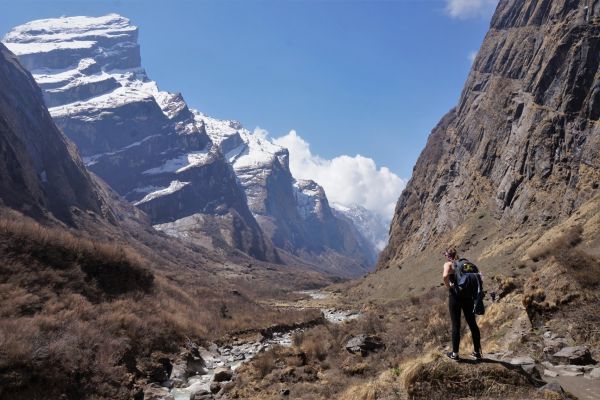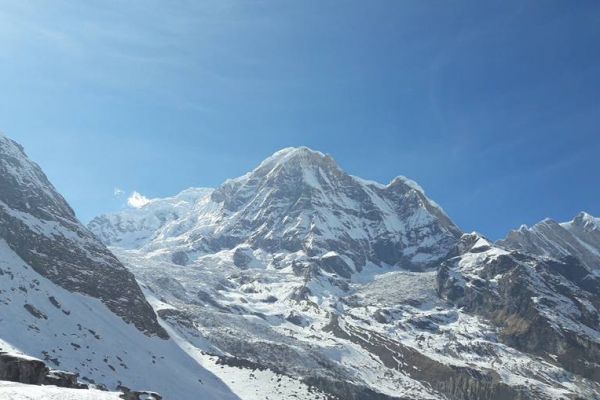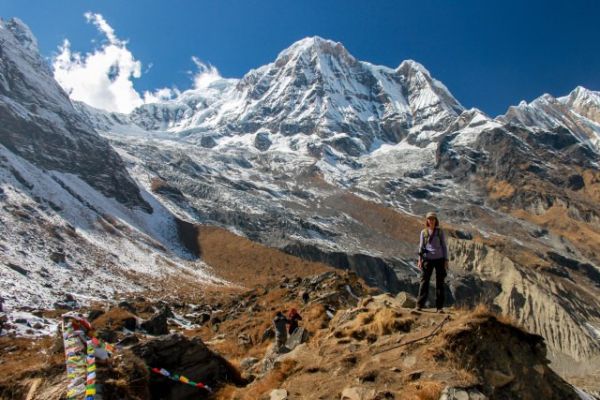- Trip Code : NTE-TJ26
- Trip Duration : 14 Days
- Trip Level : Strenuous
- Trip Max Altitude : 3300
- Trip Start Location : Kathmandu
- Trip End Location : Kathmandu
- Trip Route : Kathmandu-Nepaljung-Dunai-Rara lake-Jumla
- Trip Best Season : March-April & August-November
Trip Highlights
- The Rara lake itself serene and beautiful surrounded by numerous wild colourful flowers and grenery
- The trail that chases the final stage of world’s one of the longest trekking trails- Great Himalayan Trail
- Isolated Yari Valley
- Encounter with unique culture and traditions of Native People
- Explore breath-taking Rara Lake
- Visit Rara National Park
- Witness wildlife and Bird species
- Stunning Mountains Views
- Jumla Valley
- Scenic Flight
Trip Information
This amazing Rara and Jumla trek is one of the most famous treks in the remote wilderness of far-western region of Nepal. Situated at an altitude of 2990 meters, Rara Lake is extremely beautiful and tranquil lake with its crystal-clear water which is really spectacular to witness. It is one of the most fascinating treks that offers us to explore one of the biggest lakes in Nepal and enjoy with the virgin natural beauty and cultural uniqueness which is still unexplored in the area. Many adventurous trekkers love this trek due to its charming trekking routes, bird watching, camping and many more. The biggest lake called Rara Lake lies inside the smallest Rara National Park and makes this area into a blessed natural wonder filled with different kinds of flora and fauna.
Rara is a unique spot in the remote location of Nepal and natural panorama around the Rara Lake is the pride of western Nepal which explore its hypnotic aura and bewitching charm. It is one of the best calm heavens in the isolated location surrounded by the wonderful forest and paradise for bird watchers. Rara National Park, the smallest park in Nepal is often considered as one of the finest and smallest parks in the world that abounded in coniferous forest and is the ideal habitat for the Himalayan black bear, musk deer, and other fauna. The way to Rara and Jumla is quite off beaten however it encompasses natural and cultural site of Nepal. The reflection of the snow-capped Himalayas in the gorgeous lake provides you with an ideal feeling throughout your journey. The Rara and Jumla trek is offers you the glorious snow-capped peaks, delightful and enchanting abundant wildlife, peaceful surrounding, numerous rare and endangered flora and fauna, gorgeous Rara lake, Rara National Park and many more to enjoy your trip.
Rara and Jumla trek begins after flying from Kathmandu to Nepalgunj with glorious views of Dhaulagiri range, and attractive Nepal’s western landscapes. Then you will take a connecting flight of Jumla and you will take a rest that day. From nest day we can officially begin our trail towards Rara lake. The trail of Rara and Jumla trek allows enjoying the dramatic display of clear high summits of lakes mingled with juniper, spruce, pine and rhododendron forests with awesome views of snow-capped Himalayans peaks.
Note:- Above mention information is just the guide line and a standard template of what we provide. The trip can be customize at your request to accommodate your specific require programmed the timeframe for the trip.
Short Itinerary
- Day 1 - Arrival at Tribhuvan International Airport.
- Day 2 - Kathmandu sightseeing.
- Day 3 - Nepaljung - Fly Jumla - Danphe Lagna (3300m).
- Day 4 - Danphe Lagna – Chautha (2770m).
- Day 5 - Chautha – Dhotu (2380m).
- Day 6 - Dhotu – Rara Lake (2980m).
- Day 7 - Rest Day in Rara Lake (2990m).
- Day 8 - Rara Lake - Gorosingha (3190m).
- Day 9 - Gorusingha - Sinja (2440m).
- Day 10 - Sinja - Jaljala Chaur (3270m).
- Day 11 - Jaljal Chaur - Jumla (2370m).
- Day 12 - Jumla to Back Nepalgunj and Kathmandu.
- Day 13 - Kathmandu Rest Day and enjoy farewell dinner.
- Day 14 - Final Departure.
- Day 1 Arrival at Tribhuvan International Airport.
- Day 2 Kathmandu sightseeing.
- Day 3 Nepaljung - Fly Jumla - Danphe Lagna (3300m).
- Day 4 Danphe Lagna – Chautha (2770m).
- Day 5 Chautha – Dhotu (2380m).
- Day 6 Dhotu – Rara Lake (2980m).
- Day 7 Rest Day in Rara Lake (2990m).
- Day 8 Rara Lake - Gorosingha (3190m).
- Day 9 Gorusingha - Sinja (2440m).
- Day 10 Sinja - Jaljala Chaur (3270m).
- Day 11 Jaljal Chaur - Jumla (2370m).
- Day 12 Jumla to Back Nepalgunj and Kathmandu.
- Day 13 Kathmandu Rest Day and enjoy farewell dinner.
- Day 14 Final Departure.
Price Includes
- Arrival and departure airport transfer
- Standard hotel accommodation in Kathmandu and Nepaljung on Twin share with breakfast
- Domestic flight Kathmandu-Nepaljung-Dunai and Jumla-Nepaljung-Kathmandu
- Welcome dinner with cultural program
- Full day guided cultural tour in Kathmandu with heritage entrance permit
- Teahouse / lodge accommodation while on trek on twin share
- Full board meals while on upper Mustang Tiji festival trekking.
- Properly boiled drinking water, tea and coffee
- Upper Mustang special trekking permit for the Tiji festival trek
- Annapurna conservation entry trek permit and other trek documentation.
- Pokhara Jomsom Pokhara airfare with airport tax
- Private transportation from Kathmandu to Pokhara drive
- Free use of trekking gears like sleeping bag, down jacket, liner, trekking poles etc
- Complementary trek duffle bag and T- shirt to every trekkers
- Medical trained experienced trekking guide with first aid kit
- Trek Sherpa and porters with all their gear, wages and insurance etc.
- A Kathmandu city map and Mustang region trekking map
- Comprehensive pre departure and trip dossiers for the mustang trek
Price Does not Include
- Nepal entry visa and your personal travel insurance of any kind
- International airfare
- Drinks and main meals while on city like Kathmandu and Pokhara
- Tips and items of personal nature expenses like postage, laundry etc
Trekking equipment and clothing needed for this trek
Accommodation
We will be staying in 3 star or Similar hotel in Kathmandu and Pokhara. The best available teahouses during the trek. All accommodations are on twin-shared basis. Single supplement will be served on request and will cost an additional USD 390. Please understand that since you will be trekking in remote regions, the services in the teahouses will be basic. We will try our best to arrange rooms with attached washrooms; however, teahouses in some places do not have attached bathrooms.
Meals
During our trek, we can enjoy authentic Nepalese food as well the more common international cuisine (Tibetan, Continental, Italian, Indian, etc.). Breakfast and dinner will be served from the teahouse or from a lodge menu where we spend the night whereas lunch will be served on the way to the next destination. All meals will be provided during trekking while only breakfast will be available in Kathmandu and Pokhara. There will also be welcome and farewell dinners for guests.
Team Composition
For this trek there will be one leader, assistant leader (4 trekkers: 1 assistant guide) and Sherpa porters for carrying luggage (2 trekkers: 1 porter). This arrangement ensures that should anybody in the group get sick, the trip can still go ahead as planned. We can run the trek for groups of any size but we after years of experience we have found a maximum of twelve people to be the optimum size for a successful trip. However, if you'd like to book this trip for a larger group then that can be arranged too.
Physical Condition & Experience Requirements
Upper Mustang Trek is a moderate trek suitable for passionate walkers who have the ability to walk at least five hours a day with a light rucksack. In some days we might even need to walk for longer hours. Walking in higher altitudes is more physically demanding than walking in the lower altitudes; however, if we are in excellent health with average physical fitness, have a positive attitude and strong determination, we can accomplish the trek successfully. Exercising and jogging regularly for some weeks prior to the trip is good idea to enhance our strength and stability. Past hiking experience would be an asset but it is not mandatory. Participants with pre-existing medical conditions such as heart, lung, and blood diseases should inform Himalayan Glacier before booking the trek. We also recommend that you consult your doctor(s) before the trip.
Best Time to Travel
Spring (March to May) and Autumn (September to November) are the best months for Upper Mustang Trek. Although this trip can be taken during winter, the cold temperature might not be suitable for everyone.
The price per person for the Small group Journey is fixed as stated below. There is also the option of private and tailor made journey best suited for you, your family and friends. The discount is subjected to increase with the number of people in your group. Bigger the group better the discount so group bookings are highly encouraged.
Frequently Asked Questions
- All your departure is guaranteed to run?
- Do I need to tip my guide and porters? How much would that be?
- Can I add extra days to my trek or trip?
- Do you use Yaks and porters on the trek or do we carry all of our own gear?
- Will there be a place to store items clothing not require for the trek?
- Can I charge my digital camera, mobile or other equipment on my trip?
- Is there any communication while we are on trekking?
- Do you guys have a PAC portable altitude chamber?
- If I am sick can I continue the trek next day after a day rest?
- What if I am badly sick in the Mountain?
- Is Nepal Travel Expedition staff insured?
- What safety measures are in place? What safety equipment do your guides carry with them on the trek to deal with altitude sickness/accident?
- Do your guide have trekking guide certificate from the government tourism center? Have they received first aid training for high altitude?
- What is the weather and temperature like in trekking?
- What is the best session for this trekking?
- What is your cancellation policy?
- Is it possible to reserve a trip now pay deposit later or do I have to pay deposit at booking reservation?
- Do we book own international flights to and from Nepal?
- In case of cancelled flight due to weather condition, how do we reach Lukla from Kathmandu and vice versa?
- What is the alternative option if my flight to and from Lukla is delayed or cancelled?
- What mode of transportation do you use?
- How much additional money do I need per day for the trek?
- What are the opportunity will I have for the shower along the trek?
- What is the drinking water facilities in the mountain?
- If I am vegetarian, is that a problem?
- Is the food in mountain prepare to international standard in terms of safety?
- What are the Toilet facilities in the tea house or guest house in the trekking route?
- What short of accommodation can I expect in Kathmandu and in the trekking?
- What types of extra document do I need?
- Can I obtain visa for Nepal upon on arrival at airport?
- Will somebody come to pick me up at the airport upon my arrival?
- What types of Shape do I need to be in this trip?
Note:- Above mention information is just the guide line and a standard template of what we provide. The trip can be customize at your request to accommodate your specific require programmed the timeframe for the trip.
Trip Note:- During the trip you might face different different problems such as weather, local politics , transport or a multitude of other factor that are beyond our control could bring change in the programmed. However every unlikely that the itinerary would be substantially atered, if alternative way is necessary, then the tour leader will take decision that the best alternative option. We try to make understand everything clear that we can to minimize its effect but we can not ensure unseen result of changes or delays.
Flight delay in Nepaljung-Talcha-Nepaljung
Tamcha airport is located on a wonderful valley surrounded by high mountains. Due to this reason to landing and taking off those airport is considered be difficult and techinical issue. The weather in the areas unpredictable and likely to change every few hours resulting the flight might delay or cancellation in mountain weather condition is always changable we could not ensure even the weather forecast could not get right information.
Domestic Airlines
Nepal Domestic aircraft are Twin Otter and Dornier planes are the primary mode of transport service to and from the airstrip at lukla and jomsom. In mountain range flight is fairly depandable in weather condition however if the flight are cancelled due to weather condition to lukla, from kathmandu, to jomsom and from Pokhara we also can help you charter a helicopter to ensure you are on schedule for your trip and to catch International flight connections. The extra charges incurred are approximately couple of thousand USD 500-2500 per person would be applicable to you for the charter a helicopter. Normally Helicopter takes 4-6 people at a time and cost can be shared amongst the passangers. The heelicopter charge must be paid by the participant, which can later be submitted for reimbursement through travel insurance company. We can aslo help you with the necessary documents for a claim. Payment must be pait at the time service used by the passengers by USD cash or credit card, visa card, master card, american express are accepted for the helicopter trensport service. For the payment from any card require 4% bank service charge which goes directly to the bank.
Helicopter can fly in the visibility is 1500 meter, while the twin otter and dornier planes can fly if the visibility is 5000 meter or more as per the Nepal civil avation rules. If weqather condition is extrime or poor visibility than 1500m helicopter are also not operated. Also situation keeps on getting repeated for many days then you would be provide with alternative option for the trek and tour.
Why this trip make different?
Nepal Travel Expedition works closely with One of the main supporter's Charity service in Nepal. And contribute 10% of the tour cost for Orphan Childrens (sherpa Outdoor Foundation) We support them in many different ways.
Donation and Charity!
Nepal Travel Expedition donates 10% of its annual revenue to Sherpa Outdoor Foundation Orphan Children Home Which is Located in Lalitpur one can visit while you are in Nepal after or before the trip. We support Children's for Food, School, Clothes, Medicine also supporting stationery materials to Government School which is located at Lamjung district trying to build a library for them where they could find a different book to read. For this project, we are trying to collect donations.
Sponsorship and Partnership (volunteering programmed)
One of the major activities of Sherpa outdoor Children home in Lalitpur is fully conducted and collaborate with Nepal Travel Expedition and sister concern organization Nepal wildlife safari. The Volunteering concern programmed delivered by Nepal Travel Expedition and Sherpa Outdoor Foundation aims to mobilize a team of experts and interested individuals as an economic measure in providing human capital for education, health, community to share teaching skill various Government school in a different part of the country and community to delivered humanity skills also in our children home.



